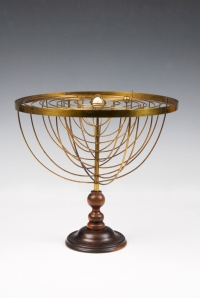RESPONSE #5 Elin Jones
The history of scientific knowledge, a field which has borne much innovative study in recent years, has often led us to see scientific discovery and the physical outcomes of these discoveries, as a process completed. In the study of the eighteenth-century, it is all too easy to see the quadrant, the orrery, or the chronometer as finished product. Even in spite of our implicit knowledge that scientific instruments must have been tried, tested, had parts replaced, removed, and even failed altogether, the Whiggish sense of science as progress, and thus an emphasis on the object as a clearly defined ‘invention’, is often tempting in our imaginings of the past.

Planetaria made of brass probably by John Rowley and dating to c.1700, Museum of the History of Science, Oxford
As Simon Werrett demonstrated to us in our last meeting, to treat objects of scientific knowledge merely as complete is to deny the importance of experiment, recycling, reuse and waste, all of which were prevalent in early modern science practices. Simon discussed the ways in which early modern scientists would continually recycle materials. Scientific investigations were imbued with a sense of ‘make do and mend’, often using the domestic spaces as sites of experiment and creation. The new scientific practices of the seventeenth century then were not ‘new’, but rather piecemeal creations, tried and tested in the home, and often formed Frankenstein’s monster-like from the pieces of other objects. Physicians used ‘any old iron’, whilst natural philosophers shared materials between groups of friends and relatives.
What struck me about the discussion which came out of the meeting was the object as an archaeology of ideas. Whilst this may well remain obscured from us initially when we look at an object, scientific or otherwise, the material artefact belies layers of human thought; most of which will not be present in the object’s finished and successful version. Museum displays often do not help to quell the illusion that the scientific object is representative of something that ‘works’, something that gave purpose to innovation and scientific thinking. Even in the study of eighteenth-century material culture, many explorations have considered the ‘new’ nature of consumable objects, rather than the way things were put back together, kept as broken, or entirely repurposed from their original use.
One midshipman’s chest I am using in my own research, built for a young boy to go to sea in the early nineteenth century, was pieced together from three different seventeenth century drawers used on shore, in an attempt to create a piece of furniture which could accommodate a fledgling career at sea (National Maritime Museum, Object Ref: AAA3344).
Understanding the object as a product of its material history and not singly of its moment of creation, and allowing deconstruction as well as creation to figure in our understanding of the material world, has further allowed me to ask questions of the photographic album I have chosen as my object. The assembly of album, and the acknowledgement that these photos began as separate entities before they were collected and aligned with each other in the neat form in which they appear in the UCL Art Museum, will form a part of my negotiation of the album for the rest of the project. Furthermore, the introduction of the idea of recycling has left me asking other questions of the album. How do we recycle the meaning and cultural weight of photographs from generation to generation? What does it mean to reuse a photograph, or a collection of photographs, when it is so far divorced from its original conception? I hope to open up some of these questions during the 100 Hours Forum.
